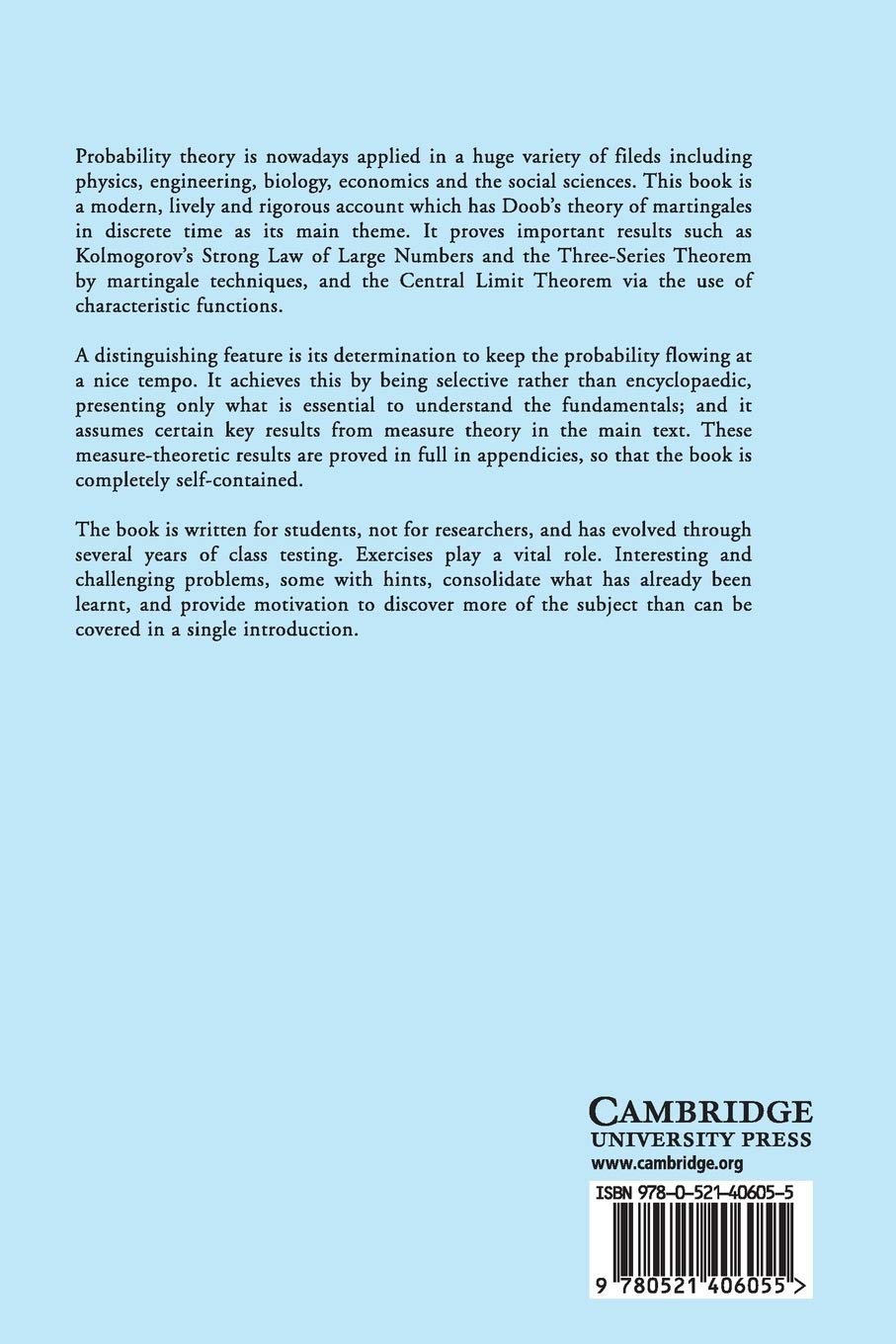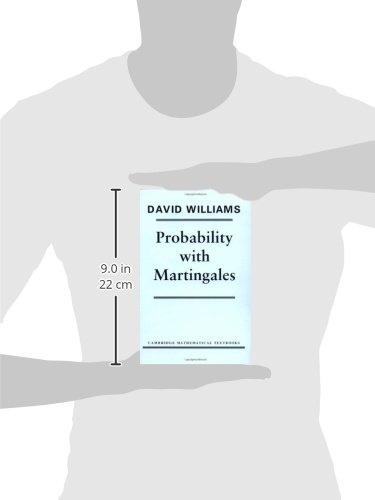



Probability with Martingales (Cambridge Mathematical Textbooks)
T**S
A great book
I had somehow studied the topic(s) during university and read that book a few years later, working as an engineer. I am not a professional mathematician.This book was quite a thrill, it really tied the pieces together and I believe I have a much deeper understanding after reading it. The lively aspect, I would say, manifests itself in that the examples chosen really drum up interest and the conciseness allows one to have an overview.It's fairly accessible, proofs included - and even if not, any hole can easily be bridged with the help of stack/mathoverflow nowadays. Some exercises are hard though, but then again it's alright, it's not the book on continuous processes from the same author!
A**N
A pleasurable read
This is a fantastic introduction to probability theory great for self-study. The primary focus of the book is discrete time martingales as is obvious from its title, and so it isn't a complete one semester course (topics which don't make a mention are infinitely divisible laws, ergodic theory, markov chains, convergence in probability measures to name a few), but neither does it aim to be. The best reason to study this book is the elegant and lively writing style of Williams.
M**N
Certainly not a book to begin self-study of probability theory but an excellent reference with plenty of pointers towards deeper applications of ...
Comprehensive and lively. Certainly not a book to begin self-study of probability theory but an excellent reference with plenty of pointers towards deeper applications of martingale theory in continuous time, stochastic integration, and filtering/control applications. The writing style can be terse but clearly motivates each concept.
Z**R
This is "the book" for Martingale Theory.
This is "the book" for Martingale Theory. It is pleasurable to read, and it is one of my favorite texts.
A**R
Five Stars
packaging was well done. product description is exactly what it is.
A**,
Disrespectful - Let down by the proofs
The material in this book is useful, the examples and exercises are great, but I give this only 3 stars because it is badly let down by the proofs. Oftentimes the proofs are stated as being too 'obvious', 'immediate' to even be written down.Consider Section 6.5, 'Sum of non-negative random variables'. Out of the 4 (fundamental) statements made in there, 3 are 'proved' by merely stating that they are 'obvious','immediate','evident' etcNow this is certainly the case for the author, but the rest of us are buying this book to understand the material, and this attitude borders on being disrespectful.Again, one needs to buy this book for the examples inside, some of them famous , eg the 'ABRACADABRA' question, but to actually learn the material and have proper proofs - there are MUCH better books out there, covering the SAME material and with COMPLETE proofs: consider 'Probability Essentials' by Jacod for instance. Don't believe me ? Compare and contrast the proof of the Holder inequality for instance !
A**N
A nice treatment of Discreet Time Martingales
Please Note:I gave it 5 stars because of Chapters 9 - 14.This book consists of three parts. I will review each in turn:Part 1: The First 8 Chapters, these covers basic measure theory:The coverage here is streamlined and the pace is fast. I learnt measure theory as an undergraduate in the mid 80's using the text Measure Theory, also the first 8 chapters, by Halmos. The treatment here, if one is to take appendices 1-3 seriously, is almost at the level of Halmos, but the style, which is geared towards the probabilist, a lot more enjoyable. My only complaint, treatment of product measures and Fubini's theorem in section 8. One would do well to supplement this with the relevant section from Bilingsley's Probability and Measure.Part2(The Core): Six Chapters on conditional expectation and discreet time martingale theory, one on applications:The real beauty of this book is - modulu the chapter on applications, which like part three should have been left out - is in chapter 9 -14.Chapter 9: Is a very nice treatment of conditional expectation. Its existence is proved using basic Hilbert Space Theory rather than the traditional Radon Nikodym - which the author does not develop in part 1-approach. Basic rules for its manipulation are then listed and proven. Armed with this, and the results from part 8 the reader is now finally ready to study martingale theory which is the subject of the next 5 Chapters.Chapter 10: Is concerned with definitions. Martingales, Submartingales, and Super martingales - collectively called Smartingales, Chung's terminology - are defined. Optional times are defined. A very simple proof showing that Stopped Smartingales are Smartinglaes is given. Various versions of the Optional Sampling theorem - though not the most general, since uniform integrability and hence closure has not yet been defined -are proved.Chapter 11: Only three pages. This motivates and gives a lovely proof of the Submartingale Upcrossing Theorem. The proof is so intuitive and simple, in marked contrast to that given in Billingsley. Various limit theorems - assuming L1 boundedness - are then proven, though none showing convergence in mean, for these the reader must wait till chapters 12 and 13.Chapter 12: Defines the concept of L2 bounded martingales. Then digresses for 8 pages. This digression builds some machinery and uses it to prove both Kolmogorovs Three Series Theorem and the Strong Law of Large Numbers. The chapter ends by proving that every process X - in L1 - can be decomposed into:X = X0 + M + AWhere A is Predicitable null at 0 and M is a Martingale null at 0.In the case where X is a Submartingale A is shown to be increasing. This is the discreet version of the Doob Meyer decomposition, which says that every cadlag Submartingale is a Semimartingale.Chapter 13: This introduces the concept of Uniform Integrability.Chapter 14: Finally we are ready, armed with the machinery developed in 13, to prove convergence results for Uniformly Integrable Martingales. Convergence in L1, Levy's Upward / Downward theorems, Doobs SubMartingale Inequalities are all proven. Finally, a beautiful proof of the Radon Nikodym theorem is provided.Chapter 15: Applications.Part3: Three brief chapters dealing with, Characteristic Functions, Weak Convergence, the Central Limit Theorem, in that order. This part, consisting of 20 pages, would have been better left out. It is only the briefest of introductions to these areas, and therefore, given that this is a book on mathematics, should be left out. Instead, I refer the reader to Chapter 5, sections 25, 26 and 27, in Billingsley, for an excellent treatment of the above topics.
W**H
One Star
DO NOT BUY THE KINDLE VERSION......many of the equations are not readable........
Trustpilot
1 week ago
1 day ago